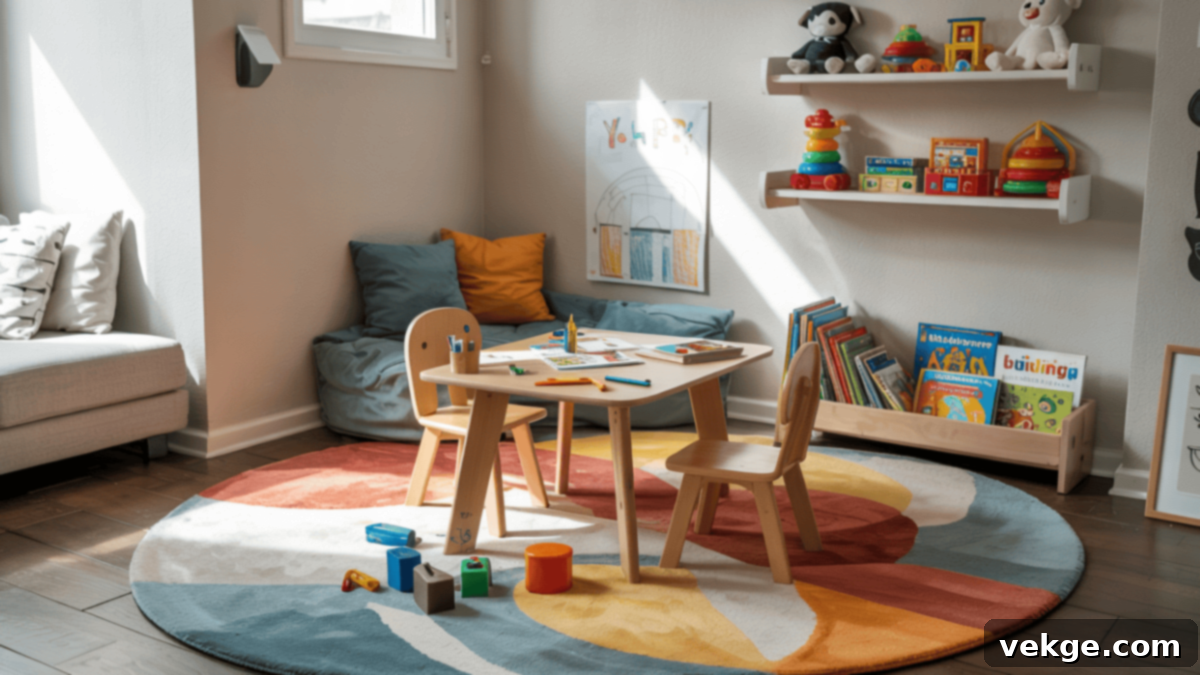Transform Your Tiny Space: 26 Smart Small Playroom Ideas for Maximum Fun & Organization
Turning a small room into a vibrant, functional playroom can often feel like an overwhelming challenge. Many parents dream of a dedicated space where their children can freely play, explore their creativity, and unwind, all without the inevitable chaos and clutter that often accompanies toys and activities. The good news is, even the most compact areas hold immense potential to become imaginative havens.
This guide is a result of my own journey, seeking effective small playroom ideas that were not only budget-friendly but truly adaptable to limited spaces. I wasn’t looking for extravagant designs, but rather smart, practical solutions to optimize what we already had. Through trial and error, I discovered transformative strategies that have kept our playroom a source of joy for my kids and a manageable space for me.
If you’re ready to convert a snug corner or a tight room into a highly functional and engaging play area, you’ve come to the right place. Here, I’m sharing 26 of the best small playroom ideas, meticulously designed to help you make the most of every inch and foster a delightful environment for your little ones.
Small Playroom Ideas to Maximize Space and Fun
Don’t let a tiny footprint limit your child’s imagination. With these clever design solutions, you can transform even the most modest play area into a highly functional, creativity-boosting space. Learn how to maximize every square inch, keeping your children engaged, happy, and your home blissfully organized.
1. Embrace Vertical Storage Solutions
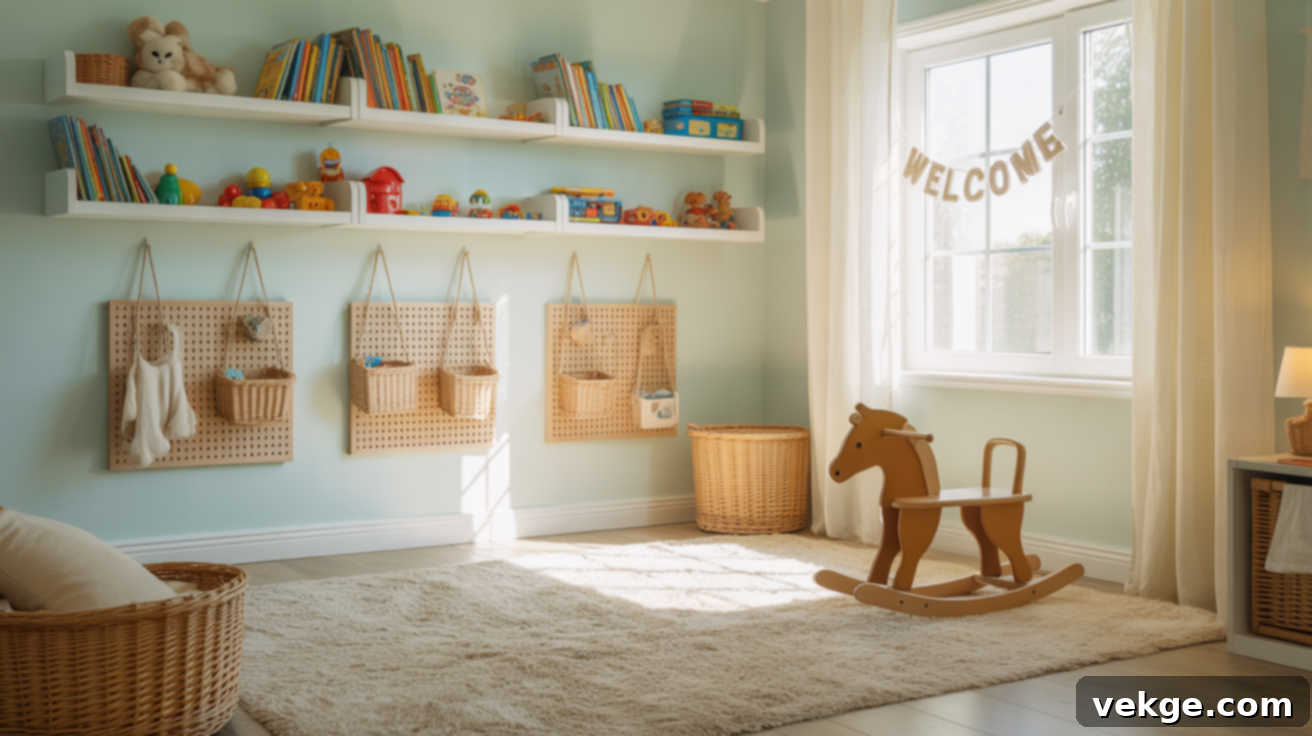
When floor space is limited, the only way to go is up! Vertical storage is a game-changer for small playrooms, drawing the eye upward and creating an illusion of greater spaciousness. Wall-mounted shelving units, tall bookcases, and hanging organizers effectively keep toys accessible while freeing up crucial floor space for active play and movement. This method prevents clutter from accumulating on the ground, making cleanup easier and play more fluid.
Consider versatile vertical solutions like pegboards with attachable baskets, hooks, and shelves. These are fantastic because they allow for easy reorganization as your child’s interests and needs evolve. Look for slim-profile options that don’t protrude too far into the room, preserving valuable walking space. You can also incorporate wall nets for stuffed animals, vertical cubbies for smaller toys, or a wall-mounted display for books, all contributing to a clutter-free and visually appealing playroom.
2. Invest in Multi-Functional Furniture
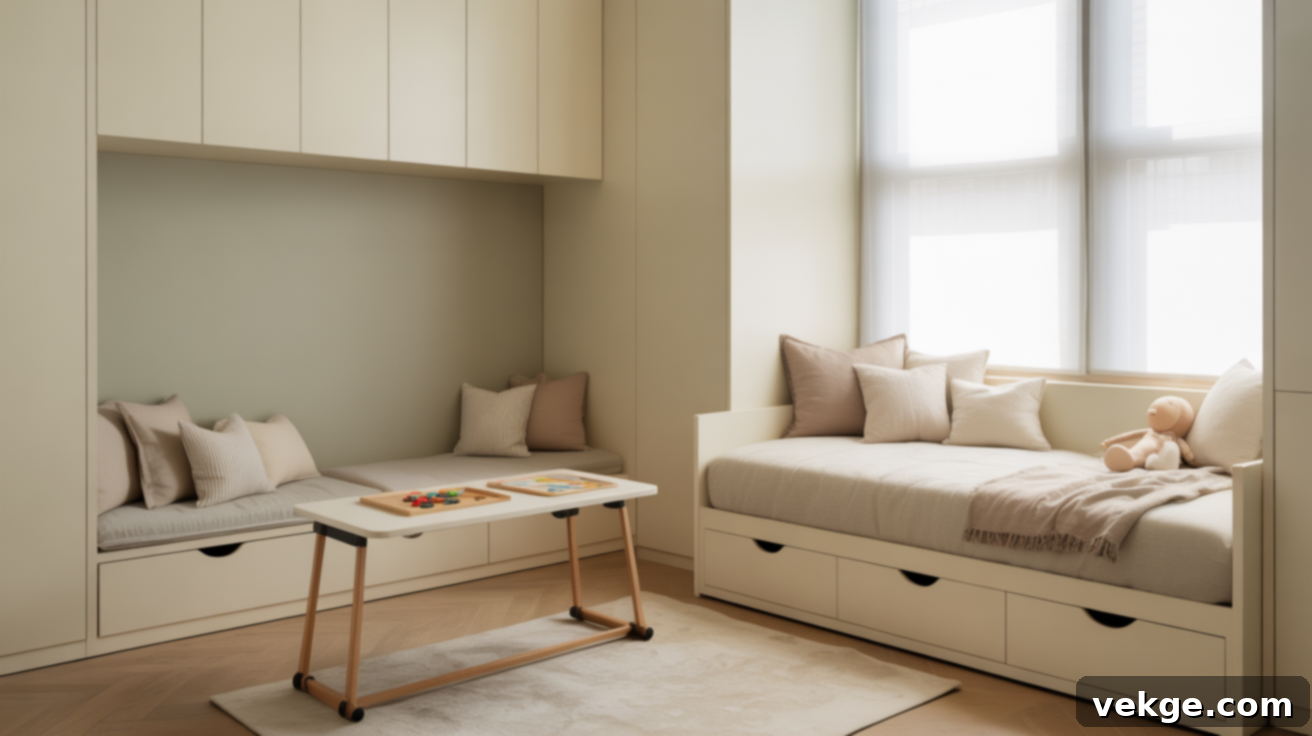
In a small playroom, every piece of furniture should earn its keep. Multi-functional items are key to smart design, serving multiple purposes within a single footprint. Think ottomans with hidden storage compartments, benches that open up to reveal toy bins, or fold-down tables that can be tucked away when not in use. These versatile pieces adapt to different activities throughout the day—from craft time to quiet reading—without consuming extra precious space.
When selecting multi-functional furniture, prioritize pieces that can grow with your child. A sturdy bench that holds toys today might become a comfortable seating area for reading as they get older. Desks with built-in cubbies or seating that converts into a sleepover spot for guests are excellent long-term investments. Opt for lightweight items that kids can safely move around, encouraging independent play and flexibility in the room’s layout.
3. Utilize Corners Wisely for Play Zones
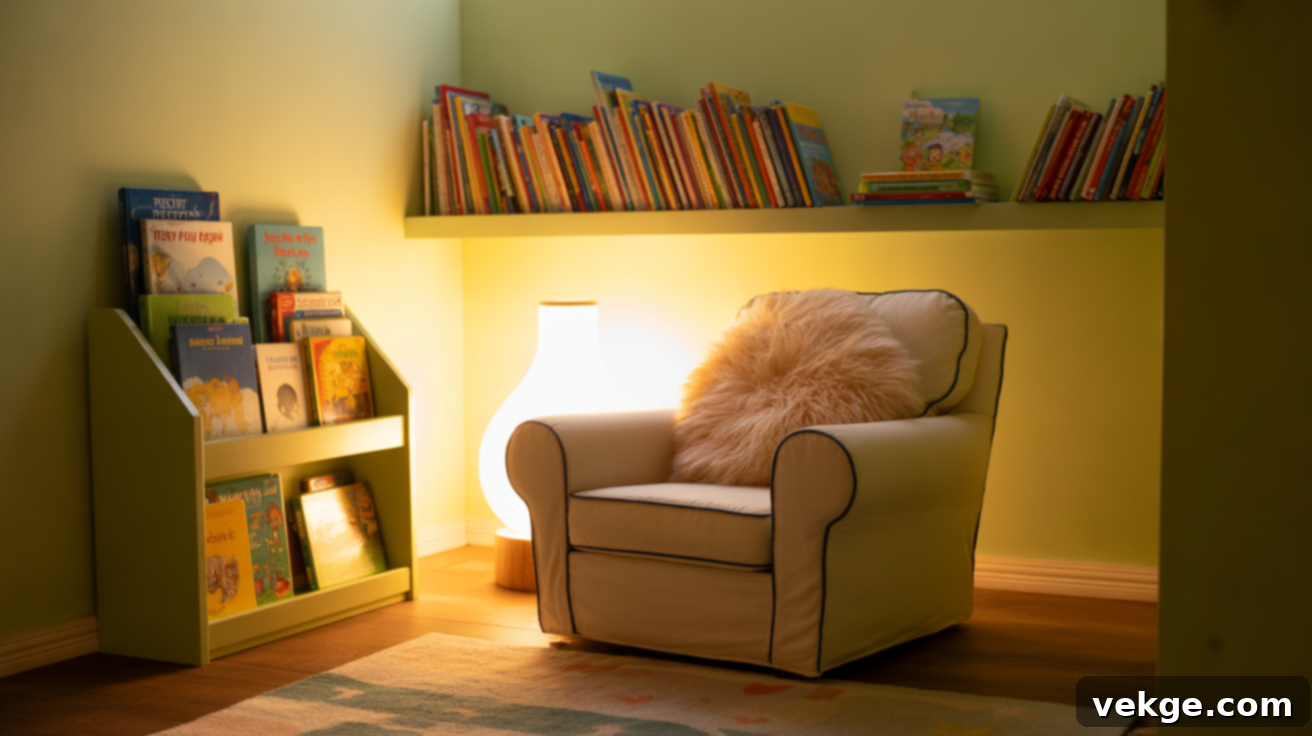
Corners are often overlooked or underutilized spaces, but in a small playroom, they represent prime real estate. Transforming these angular areas into functional zones can significantly boost your room’s efficiency. Corner shelving units can provide ample storage without infringing on central play areas, while a small, custom-built corner desk can become a dedicated homework or craft station.
Consider turning a corner into a cozy reading nook by adding a small bench or floor cushions, soft lighting, and a few wall-mounted book displays. Triangle-shaped desks or custom corner cabinets are perfect for maximizing every inch. Even simple additions like hanging fabric organizers or mini wall baskets can make corners more efficient for storing small items like art supplies or board games, preventing them from feeling crowded while still being incredibly useful.
4. Implement Under-Bed Storage Solutions
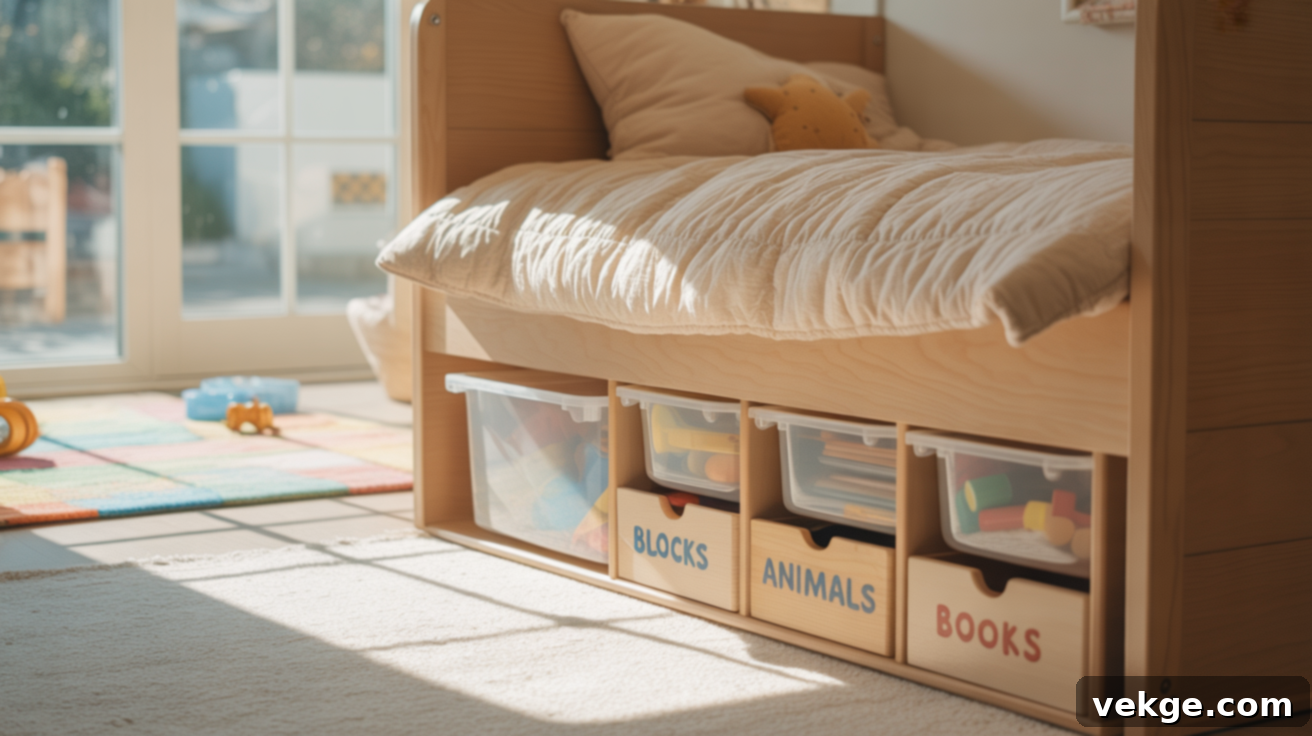
If your playroom doubles as a bedroom, or if there’s a daybed present, the space beneath the bed is a golden opportunity for hidden storage. Shallow, rolling containers designed to slide easily under beds are perfect for stowing away seasonal items, less-frequently used toys, or larger play sets. Clear bins are particularly useful as they make contents visible, empowering children to find what they need independently without rummaging through everything.
For bulky items like stuffed animals, dress-up clothes, or extra blankets, vacuum-seal bags can compress them significantly, making them fit into smaller spaces. For a more integrated and seamless storage solution, consider bed frames with built-in drawers. Always label storage bins clearly, perhaps with both words and pictures, and group similar items together. This teaches kids valuable organizational skills and makes independent cleanup a breeze.
5. Prioritize Foldable and Stackable Items
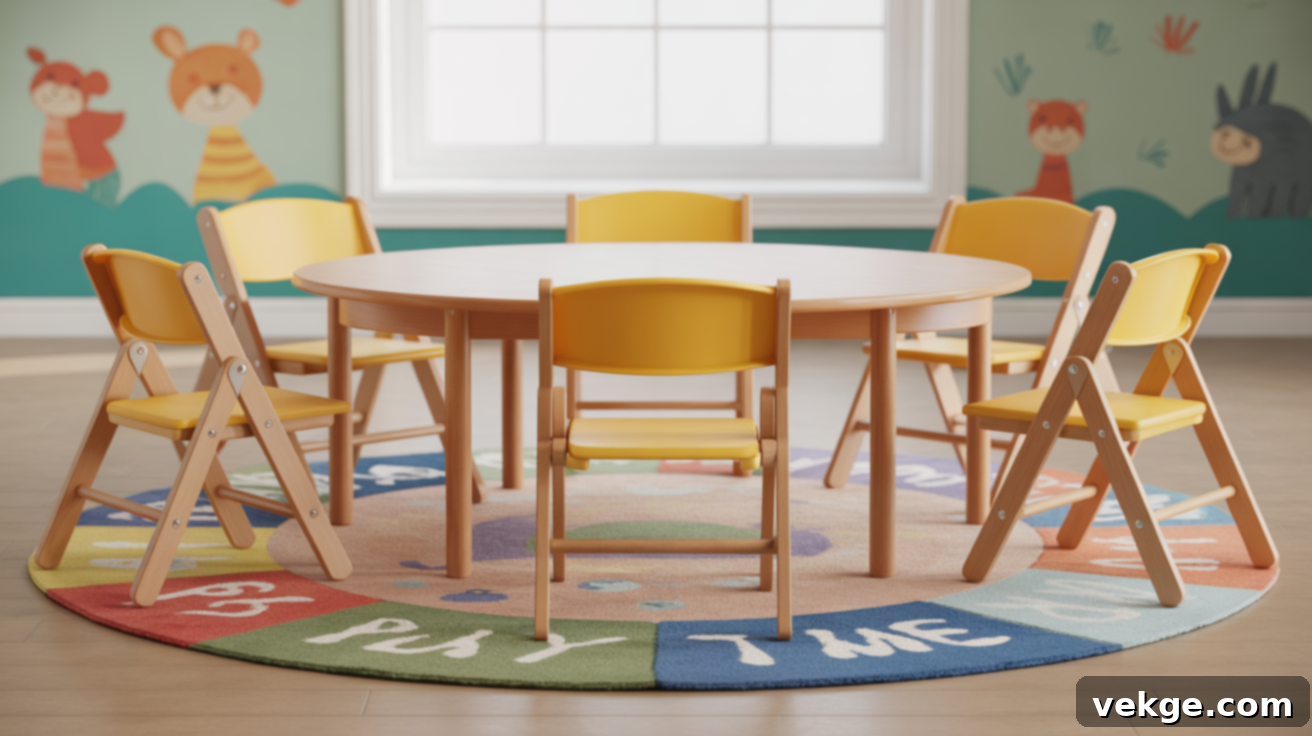
To maintain flexibility and maximize floor space in a small playroom, opt for furniture and toys that can be easily folded or stacked away. Foldable play tables, collapsible fabric bins, and stackable chairs are excellent choices because they can be quickly stored when not in use, instantly creating more open space for active play or other activities. This strategy is particularly effective for items used intermittently, like a train set or a large puzzle board.
Look for stackable storage boxes that are designed to interlock securely, preventing toppling. Nesting tables or chairs also save space. When selecting toys, consider options that pack away compactly, such as magnetic building sets or puzzles with dedicated storage boxes. This principle extends to smaller items too; shallow rolling containers can be stacked for vertical storage, then rolled out for use. The key is to choose items that minimize their footprint when not actively being played with.
6. Include a Low Play Table with Integrated Storage

A dedicated low play table is invaluable for fostering creativity and independent work, but in a small space, it needs to be smart. Opt for child-height tables that feature integrated storage bins or shelves directly beneath the tabletop. These dual-purpose pieces create a defined zone for art projects, building, or snack time without requiring additional furniture for storage. They encourage children to contain their mess and keep materials organized within arm’s reach.
When choosing a play table, look for durable, washable surfaces that can withstand spills and art supplies. Built-in compartments are excellent for teaching organization skills, as children can learn to sort crayons, markers, blocks, or puzzle pieces. Tables with adjustable heights are a smart investment, as they can grow with your child, extending their usefulness for many years. Safety features like rounded corners and sturdy construction are also essential for active play sessions.
7. Create a Reading Nook with Cushions and a Canopy
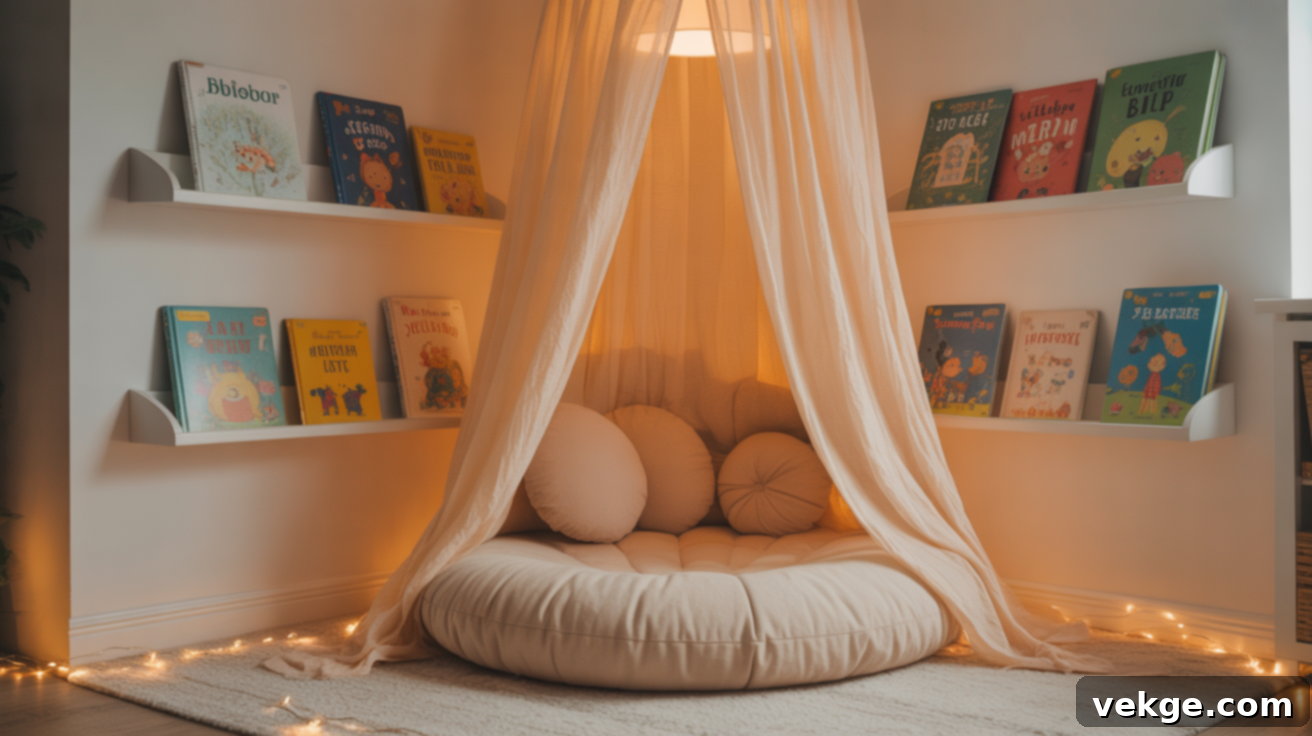
Every playroom, regardless of size, benefits from a cozy spot dedicated to quiet time and imagination. A reading nook is perfect for this, and it doesn’t require much space. A designated corner, adorned with soft floor pillows or a comfy beanbag chair, and topped with a simple fabric canopy, can transform an ordinary space into a magical, inviting retreat. This defined area helps children understand the value of peaceful activities like reading and quiet contemplation.
To keep the space efficient, install wall-mounted book rails or narrow book ledges nearby. These display book covers forward-facing, making selections appealing and easily accessible without the bulk of traditional bookcases. For an extra touch of enchantment, string some battery-operated twinkle lights around the canopy. Lay a soft rug or mat under the nook to anchor the space and provide a plush surface for little ones to stretch out and get comfortable with their favorite stories.
8. Set Up a Compact Craft Station with Art Supplies
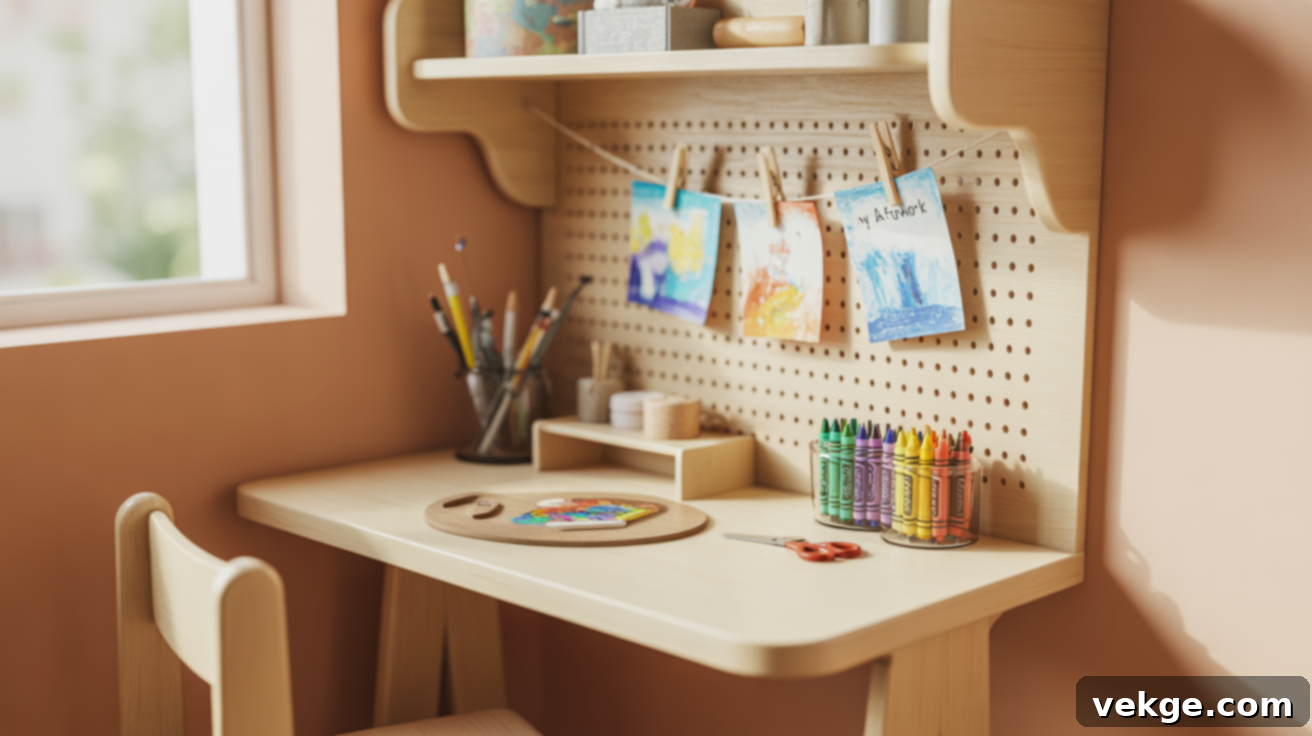
Encouraging creativity is crucial, even in a small playroom. A compact craft station can be easily integrated using vertical space. A wall-mounted fold-down desk or a narrow console table against a wall can serve as the primary workspace. The key is vertical organization: use wall-mounted organizers, pegboards, or hanging mesh bags to keep creative tools like scissors, markers, glue, and paper visible and within easy reach.
Clear jars or labeled containers are excellent for organizing smaller supplies, allowing children to independently select and return materials. Consider adding a small drying rack or a simple clothesline with clips to display finished masterpieces, celebrating your child’s artistic endeavors without adding clutter. Placing a washable plastic mat underneath the craft station can make cleanup a breeze after messy art projects. To keep the collection manageable and inspire fresh creativity, rotate art supplies seasonally.
9. Build a Versatile Pretend Play Area
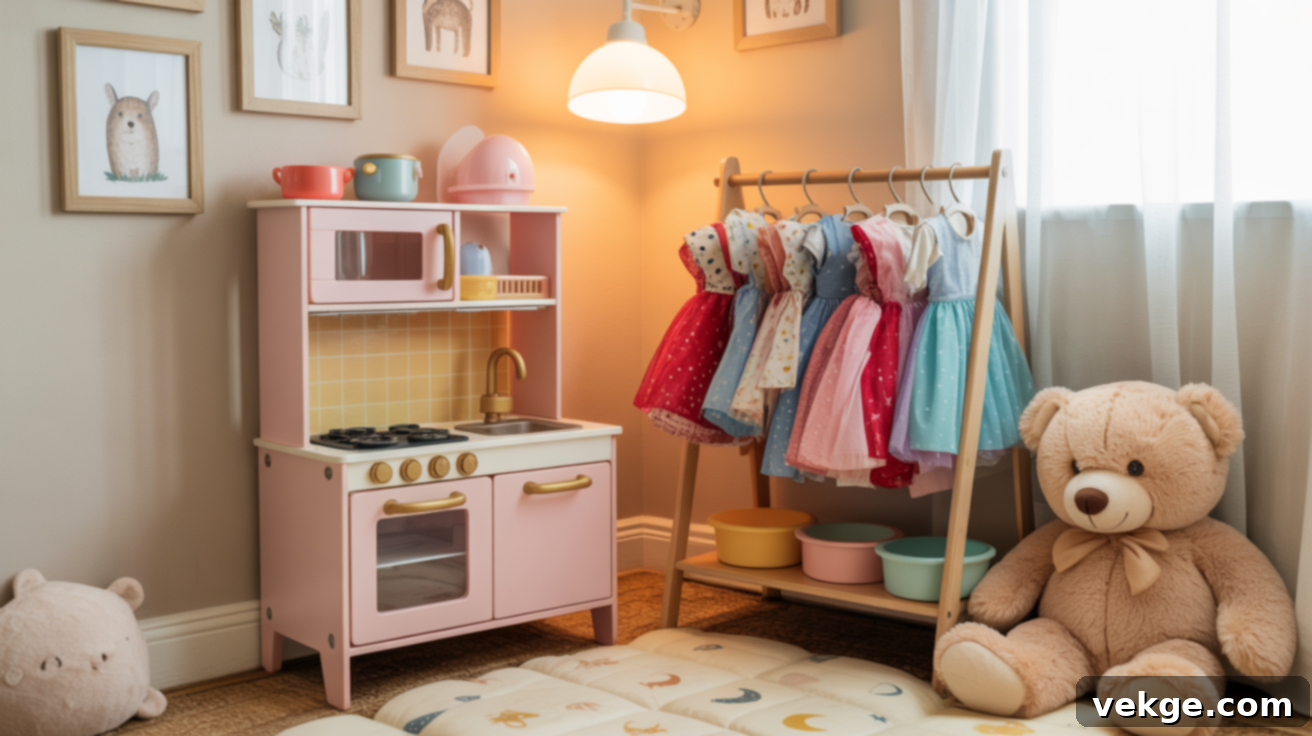
Imaginative play is fundamental for a child’s development, and you don’t need a huge area to facilitate it. A small, well-defined zone for pretend play can encourage storytelling, social development, and role-playing. Simple props are often more effective than elaborate setups. A corner play kitchen, a puppet theater backdrop created from a tension rod and curtains, or a dress-up trunk with a few key pieces can spark endless scenarios with minimal space requirements.
Keep the area fresh and engaging by rotating themed toys and props rather than having everything out at once. Wall-mounted elements, such as a pretend mailbox, a chalkboard for a restaurant menu, or a magnetic calendar, can save precious floor space. Choose versatile props that can transform into multiple scenarios: scarves become superhero capes or restaurant tablecloths, and cardboard boxes can morph from spaceships into grocery stores, fostering adaptability and ingenuity.
10. Add a Dedicated Lego or Puzzle Zone
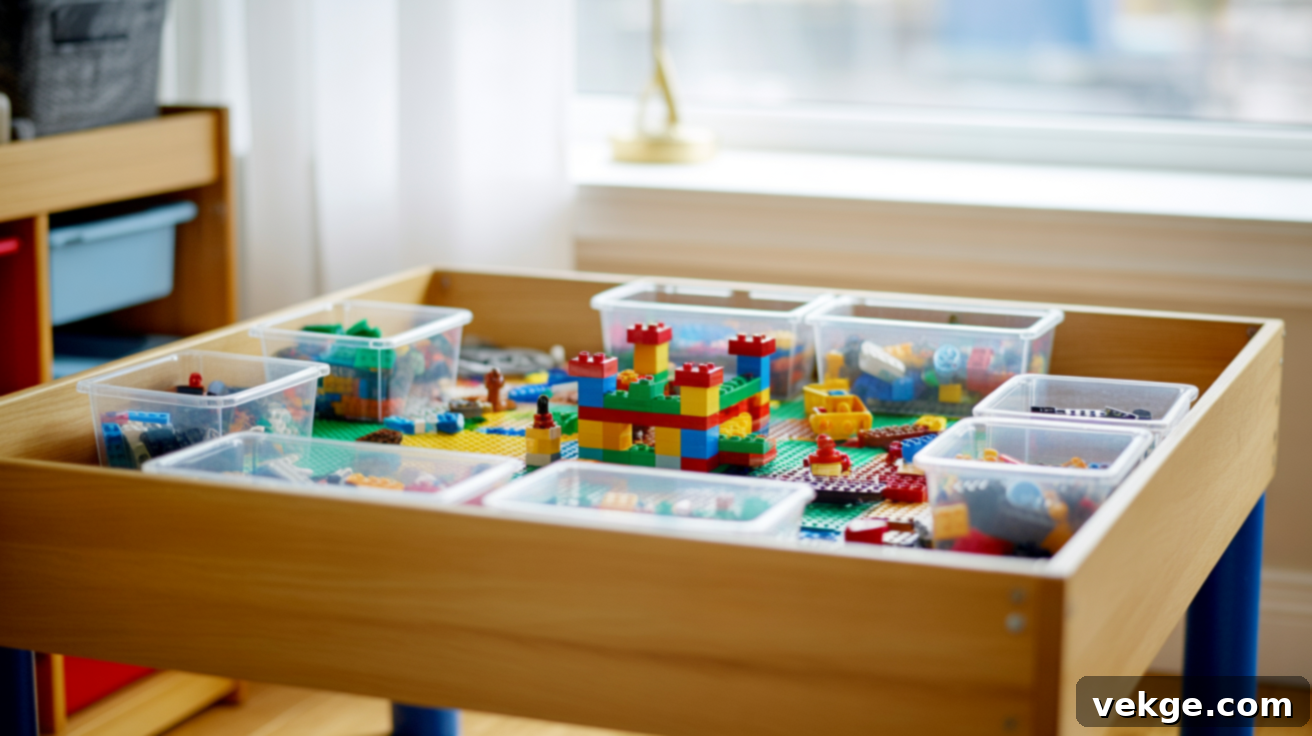
Building blocks, LEGOs, and puzzles are fantastic for cognitive development, but their small pieces can quickly become a mess in a small space. A dedicated zone helps contain these activities. A specific surface with raised edges, like a tray table or a custom-built low table, can keep small pieces from scattering and allow projects to remain in progress without being disturbed. This means less frustration for kids and less tidying for parents.
For storage, shallow bins organized by color or piece type make finding specific elements much easier. A fold-down wall-mounted table is an ideal solution as it provides a robust workspace when needed and disappears flush against the wall when not in use. Consider puzzle mats that can be rolled up with an incomplete puzzle inside, allowing play to be paused and resumed later. Label containers with both words and pictures to empower younger children to maintain organization independently, and clear lids help kids see what’s inside without dumping everything out.
11. Hang a Small Swing or Chair Hammock
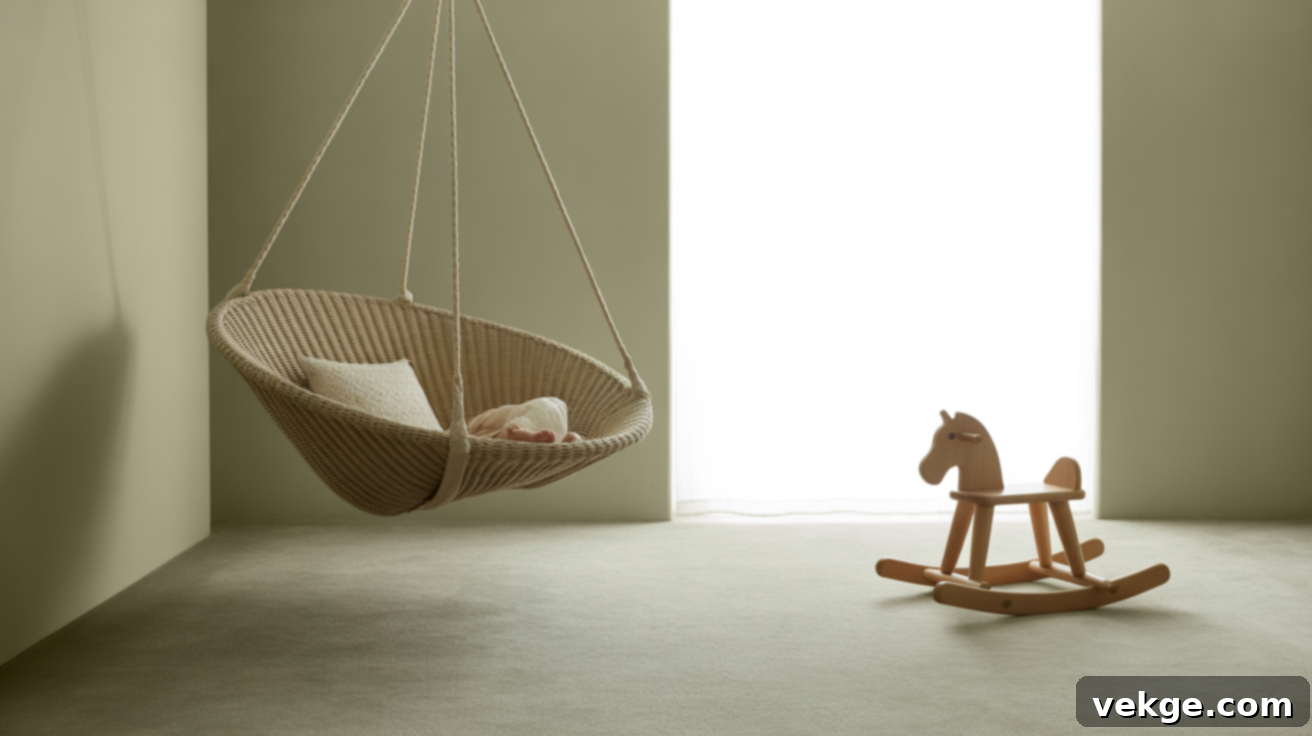
Children naturally need to move and expend energy. In a small playroom, where floor space for running or jumping might be limited, a ceiling-mounted swing or a chair hammock can be a fantastic addition. These options offer movement-based play that takes up minimal floor space, satisfying physical energy needs and providing crucial sensory input without requiring a large footprint. They also provide a calming effect for some children, acting as a quiet retreat.
When installing, ensure proper professional installation with weight-appropriate hardware for maximum safety and longevity. Choose adjustable options that can be raised out of the way when not in use, further maximizing open space. Place a soft rug or crash pad underneath for extra safety during active play. Indoor swings and hammocks are particularly beneficial during bad weather days when outdoor play isn’t possible, offering a wonderful outlet for energy and providing sensory regulation benefits.
12. DIY Stage or Chalkboard Wall
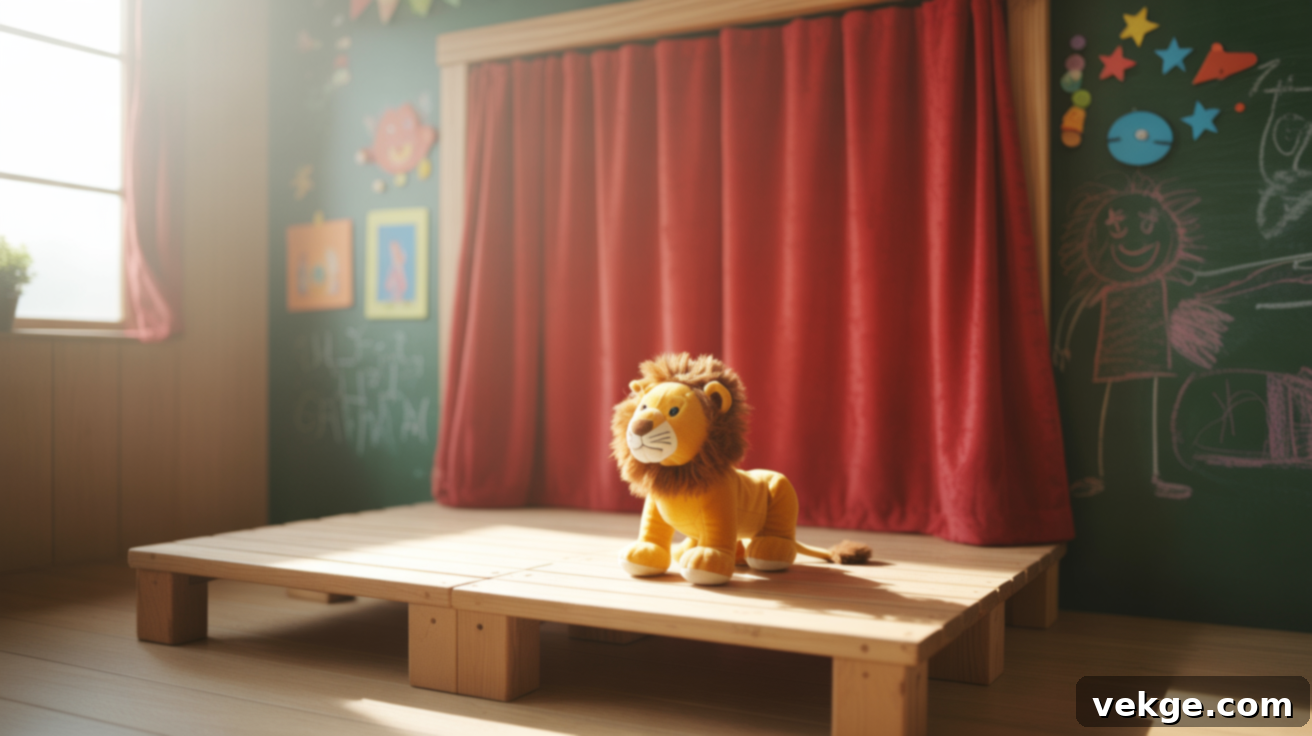
Encouraging creative expression doesn’t have to require a dedicated theatre room. A small, simple DIY stage can be created with a low platform (perhaps built with storage underneath) and a tension rod with curtains. This versatile space encourages dramatic play, storytelling, and confidence-building performances. When not in use, the platform can double as extra seating or a surface for large-scale building projects.
Another excellent space-saving idea is a chalkboard wall. A simple coat of chalkboard paint can transform an entire wall into an ever-changing canvas for drawing, writing, and imaginative scenes, all without adding any physical clutter. For even more versatility, consider applying magnetic paint underneath the chalkboard paint, allowing for additional display options using magnets, eliminating the need for space-consuming easels. Add a small basket nearby with props like microphones, simple costumes, or musical instruments to inspire impromptu performances and artistic endeavors.
13. Utilize Clear Toy Bins with Labels
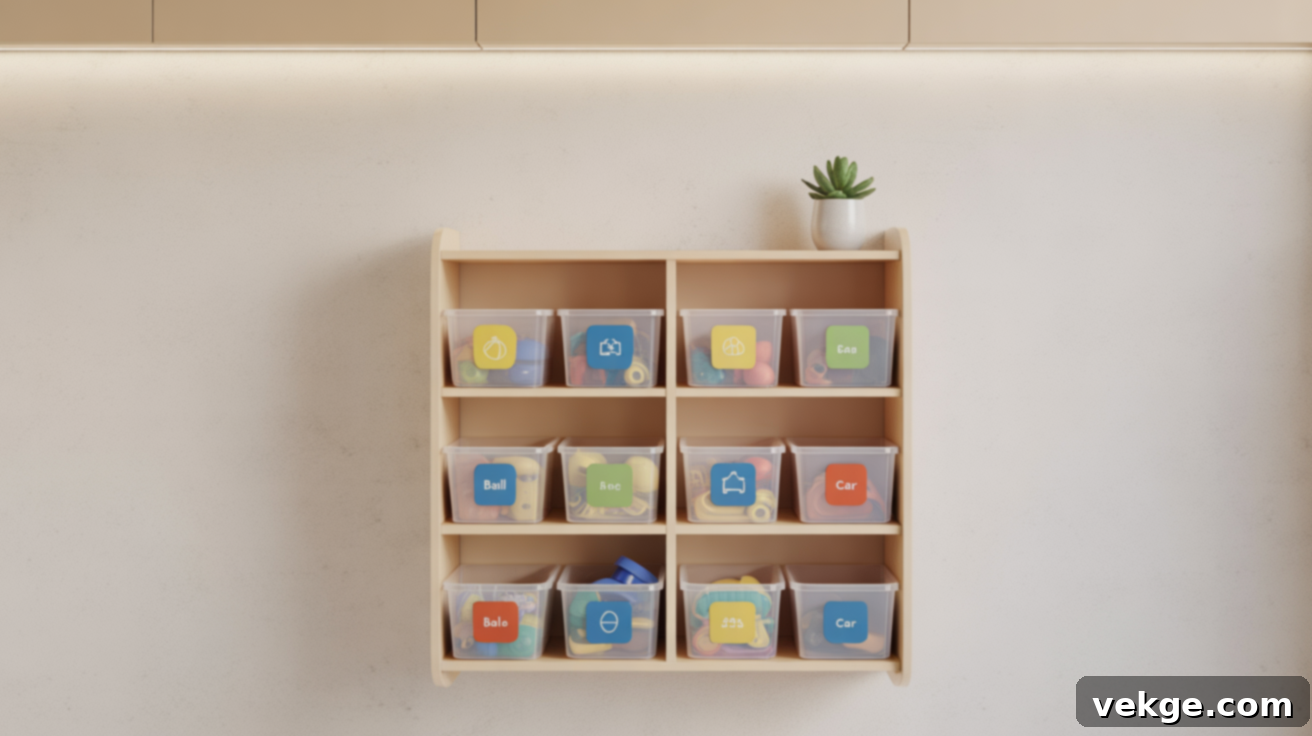
Effective organization is paramount in a small playroom, and clear toy bins are a secret weapon. Transparent containers allow children to see the contents at a glance, helping them independently find the toys they want without having to dump everything onto the floor. This visibility significantly reduces common dumping behaviors and makes cleanup much more efficient and less frustrating for everyone.
To further enhance organization and promote independence, add picture labels (for younger children) or word labels (for older kids) to each bin. Choose uniform bins that stack neatly when not in use, maximizing vertical storage on shelves or in cubbies. Color-coded labels can create a visual organization system that even preschoolers can easily maintain themselves. Occasionally rotate the positions of the bins to keep children engaged with different toys, and use the clear visibility to identify which toys haven’t been played with recently, helping you curate your collection effectively.
14. Try Stackable Baskets and Rolling Carts

Mobile storage solutions offer incredible flexibility for small playrooms, allowing play areas to change dynamically based on the day’s activities or your child’s current interests. Rolling carts, like a three-tier utility cart, can easily move from room to room, extending the playroom’s functionality throughout the house for different projects. They are perfect for art supplies, building blocks, or themed play sets that might be used in various locations.
Stacking baskets are another excellent way to maximize vertical space while keeping items easily accessible to little hands. Look for nesting options that take up less room when stored empty during unused seasons. The mobility of these solutions not only encourages children to clean up one activity before wheeling in materials for the next but also allows for quick tidying when guests arrive or when the space needs to be repurposed temporarily. They combine practicality with playful aesthetics.
15. Add Wall Hooks for Dress-Up or Bags

Don’t underestimate the power of wall hooks for organization and adding a touch of whimsy to a small playroom. Low-mounted hooks are ideal for displaying dress-up costumes, turning them into decorative elements while keeping them wrinkle-free and easily accessible. This approach cleverly transforms storage needs into playful wall decor that encourages imaginative play. Children can easily choose their outfit of the day and, more importantly, hang it back up themselves.
Beyond costumes, hooks are perfect for neatly hanging backpacks, activity bags, or small toy bags, significantly reducing floor clutter. Choose colorful hooks or decorative rails that complement the room’s design aesthetic. Install hooks at child-friendly heights to encourage independence in hanging up their own belongings. You can group hooks by function—a set for dress-up items, another for daily use bags, and perhaps a few for hanging art or small soft toys—creating an intuitive organization system that benefits both kids and parents.
16. Install Built-In or Modular Shelving
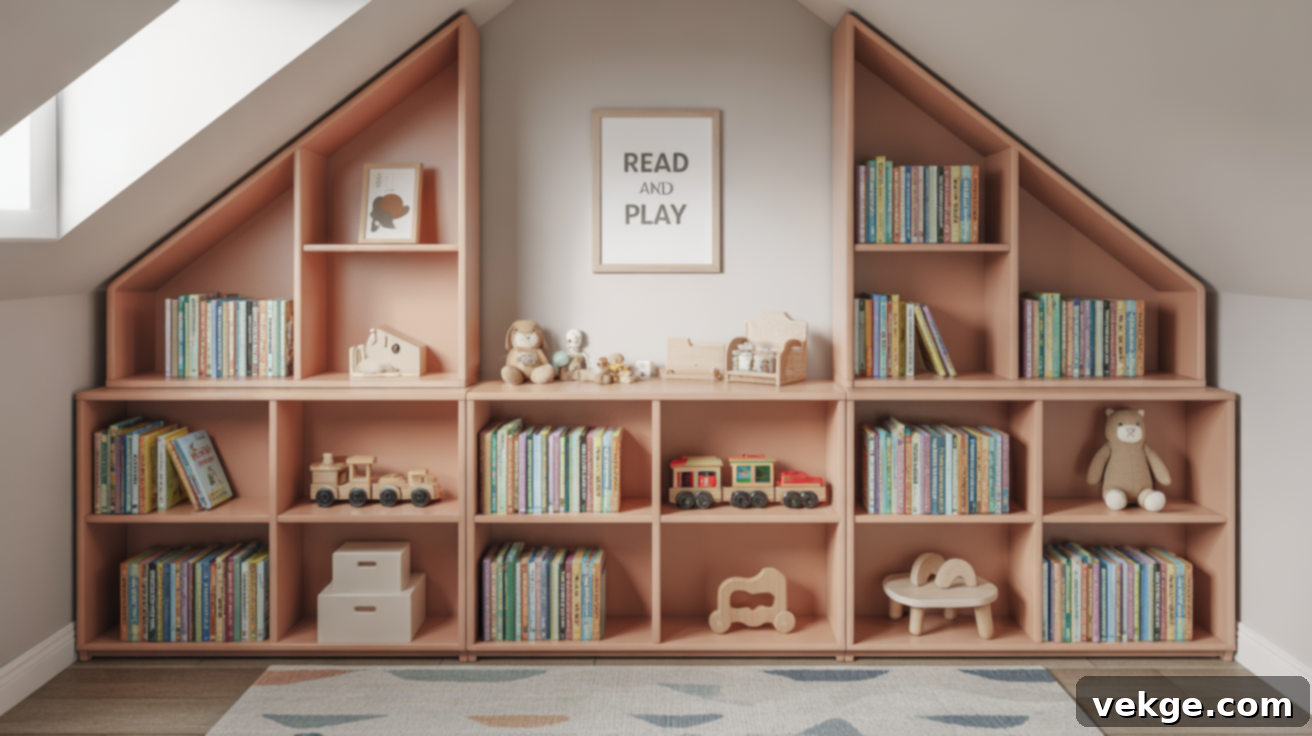
For a truly customized and space-efficient playroom, consider built-in or modular shelving. Built-in solutions are fantastic for utilizing odd-shaped spaces, awkward wall sections, or areas around windows and doors that pre-made furniture simply cannot address. These tailored solutions maximize every available inch, creating seamless storage that feels integrated into the room’s architecture rather than an added element.
Modular shelving systems offer similar benefits with added flexibility. They can grow and reconfigure as children’s needs change over the years, making them a wise long-term investment. High-quality components can easily transition from toy storage to holding school books, hobby supplies, or even serving as a decorative display as your child matures. Consider adjustable shelving heights to accommodate changing toy sizes and interests. Built-ins around architectural features can transform previously unused areas into incredibly functional and aesthetically pleasing storage zones.
17. Utilize Book Rails or Narrow Book Ledges

Traditional bookcases can be bulky and take up significant floor space. For a small playroom, book rails or narrow book ledges are a brilliant alternative. These systems allow for forward-facing book displays, showcasing vibrant covers and making selections instantly visible and appealing to children, unlike books hidden spine-out on traditional shelves. This arrangement takes up minimal wall depth, preserving precious floor space.
Forward-facing displays intrinsically encourage reading by turning books into inviting pieces of art. You can rotate featured books regularly to keep the room feeling fresh and engage children with new stories without needing additional purchases. Low-mounted rails are perfect for empowering younger children to independently select and put away their books, fostering a love for reading and responsibility. Install multiple rails at different heights to create an evolving library wall that grows with your child, offering an ever-present source of learning and imagination.
18. Choose a Storage Ottoman or Pouf
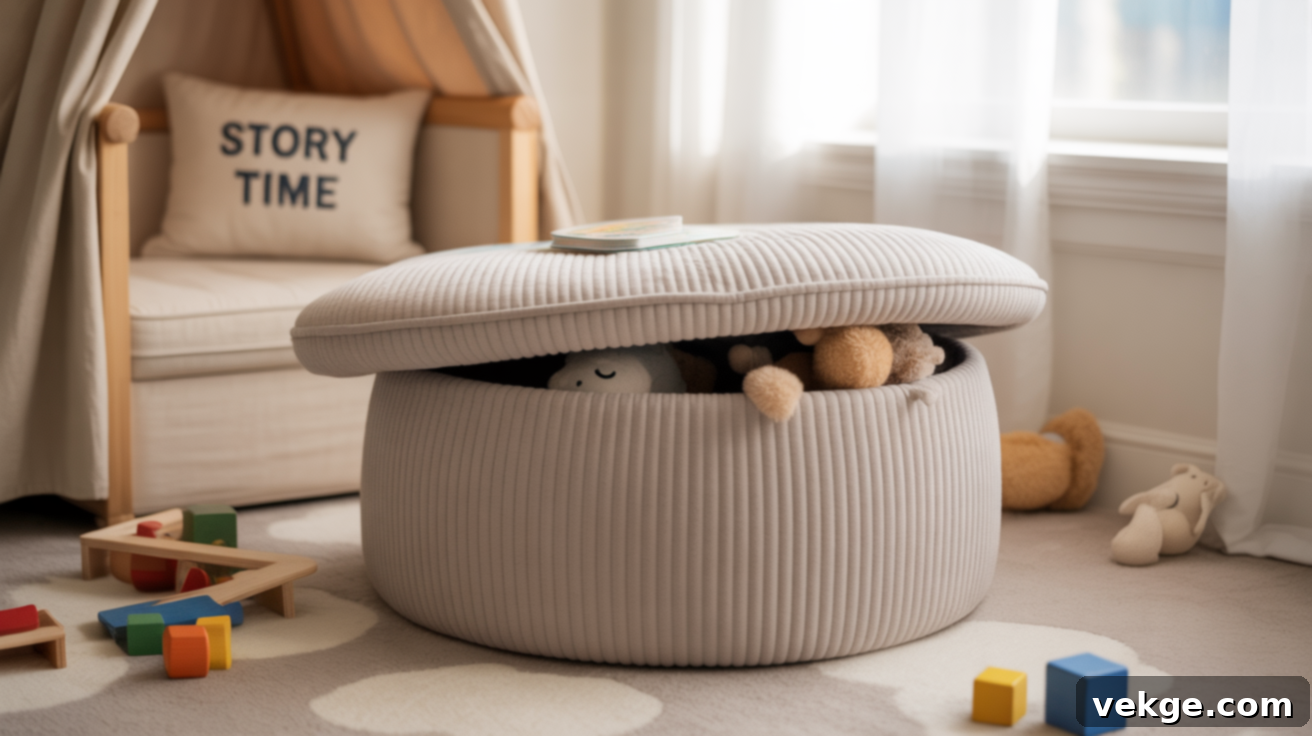
In a small playroom, every item should ideally serve a dual purpose, and a storage ottoman or pouf fits this criteria perfectly. These soft seating options provide comfortable spots for kids to sit during reading time, group activities, or simply when relaxing, while simultaneously offering hidden storage compartments. They are excellent for tucking away toys, extra blankets, or pillows, helping to reduce visual clutter and keep the room looking tidy.
Look for ottomans with durable, washable covers that can withstand frequent use and playful spills. Lightweight versions are particularly useful as children can easily move their seating around the room during different activities, promoting flexibility in play. Choose ottomans in bright colors or playful patterns to add a pop of personality and warmth to the space. These versatile pieces can also double as side tables for drinks or snacks, step stools for reaching higher shelves, or even impromptu stages during imaginative play sessions, making them a truly indispensable item in a compact playroom.
19. Stick to Light Wall Colors & Use Mirrors

The psychology of color plays a significant role in how a space feels, especially in smaller rooms. Sticking to light wall colors is one of the most effective ways to make a small playroom feel larger, airier, and more open. Pale tones like whites, creams, light grays, or soft pastels reflect natural light, making the room brighter and seemingly more spacious. This creates a calm and inviting backdrop that allows colorful toys and decor to pop without overwhelming the senses.
Strategic placement of mirrors further enhances this effect. Mirrors visually double the room’s size, creating an illusion of depth, and also reflect light into darker corners, brightening the entire space. For a child’s room, ensure mirrors are shatter-resistant (acrylic or tempered glass) and securely mounted at a child-friendly height, offering fascinating opportunities for self-discovery and expanding the visual space safely. Keep the overall color palette simple, allowing for pops of brightness through easily changeable accessories like rugs, pillows, or art, so the room can evolve as interests change without major repainting.
20. Add Wall Decals or Murals for Visual Interest
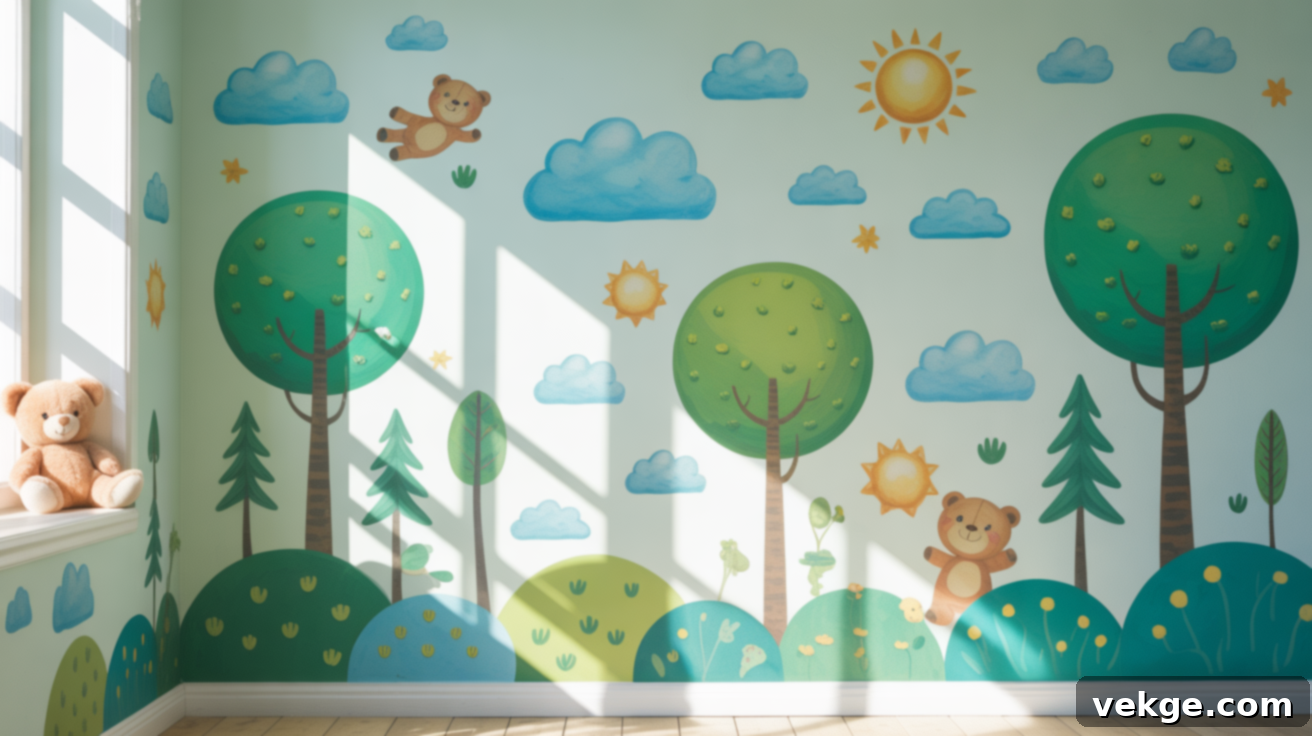
Personalizing a small playroom often means thinking vertically. Wall decals or murals are an excellent way to add personality, theme, and visual interest without taking up any physical floor space. These removable wall graphics can transform a plain wall into an imaginative backdrop for play, whether it’s a whimsical forest, a starry night sky, or a bustling cityscape, all without the bulk of three-dimensional decorations or the commitment of permanent paintwork.
When selecting decals, choose themes that inspire creativity and open-ended play rather than character-specific designs that children might quickly outgrow. Geometric patterns, nature scenes, or abstract designs offer timeless appeal and won’t feel dated. Look for high-quality decals that are easy to apply and remove cleanly, allowing for future updates as your child’s preferences change. Consider positioning decals to create interactive play zones—like a growth chart tree, a rocket ship launch pad, or a road map for toy cars—turning a wall into an active part of the playroom.
21. Place Cozy Rugs to Define Zones
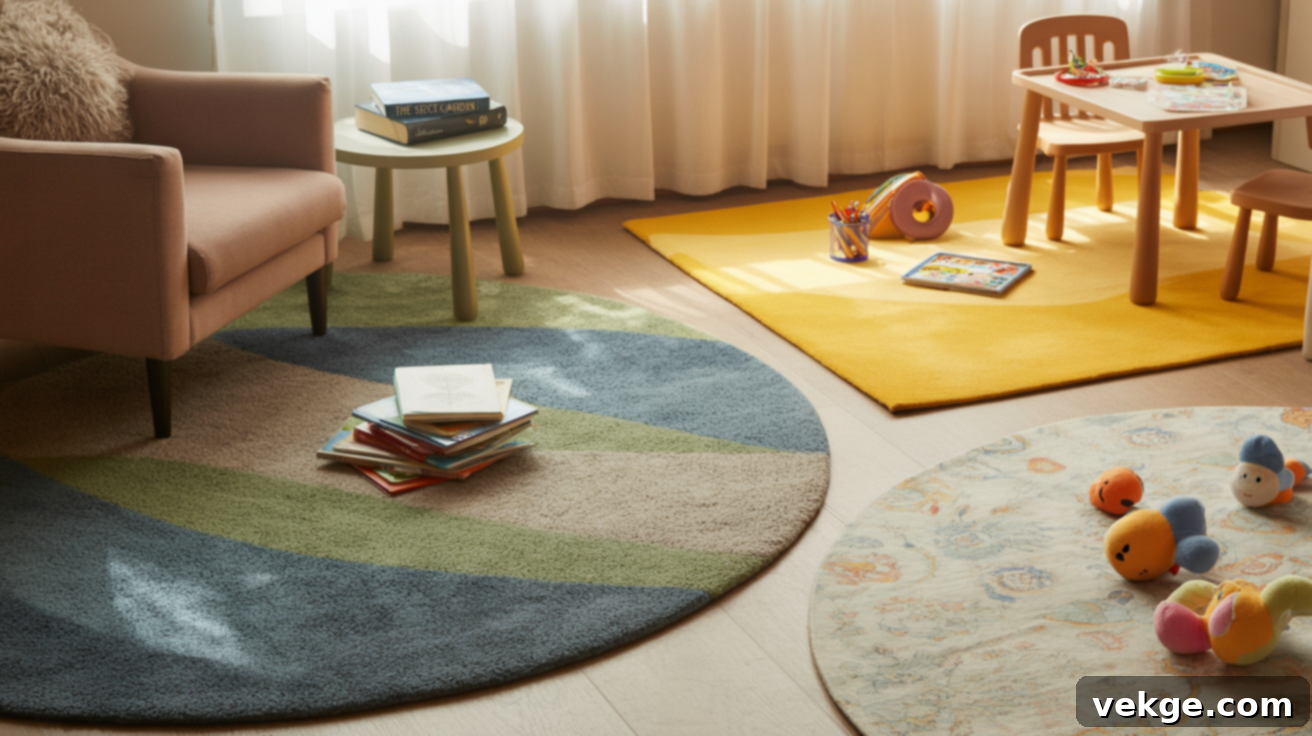
In a small, open-concept playroom, visual cues are essential for defining different activity areas without the need for physical barriers. Cozy rugs are perfect for this purpose, creating soft, inviting boundaries between various play zones. A rug might delineate the reading nook from the building area, or mark off a space for sensory play versus dramatic play. This simple division helps children understand where specific types of play belong, encouraging focus and easier cleanup within designated areas.
When choosing rugs, opt for washable, low-pile options that can withstand heavy foot traffic and potential spills, while still providing comfort during floor play. For areas needing extra cushioning during active play, consider interlocking foam tiles that are easy to clean and can be configured to fit any space. Choose rugs with interesting patterns, colors, or textures that can inspire play scenarios—a circular rug might become a pond, a striped rug a road. Always secure edges with non-slip backing to prevent tripping hazards, ensuring a safe and comfortable play environment.
22. Use Soft Lighting & Fairy Lights

The right lighting can dramatically transform the ambiance of a small playroom, making it feel welcoming, cozy, and magical. Gentle illumination, rather than harsh overhead glare, creates a more calming and inviting atmosphere. Incorporate multiple light sources, such as a soft table lamp for reading nooks, wall sconces for focused light on craft stations, or a dimmable ceiling fixture for adjustable brightness throughout the day.
Fairy lights or string lights are a wonderful addition for adding whimsical charm. Drape them along ceiling edges, around canopies, or intertwine them with vertical shelving for a magical glow. Battery-operated options are especially convenient as they eliminate cord hazards and offer flexibility in placement. Consider adjustable brightness settings to easily transition the room from active play mode to a calming bedtime routine. Nightlights with child-friendly designs can also help ease nighttime fears while providing just enough illumination for safe navigation in the dark.
23. Display Kids’ Art Creatively
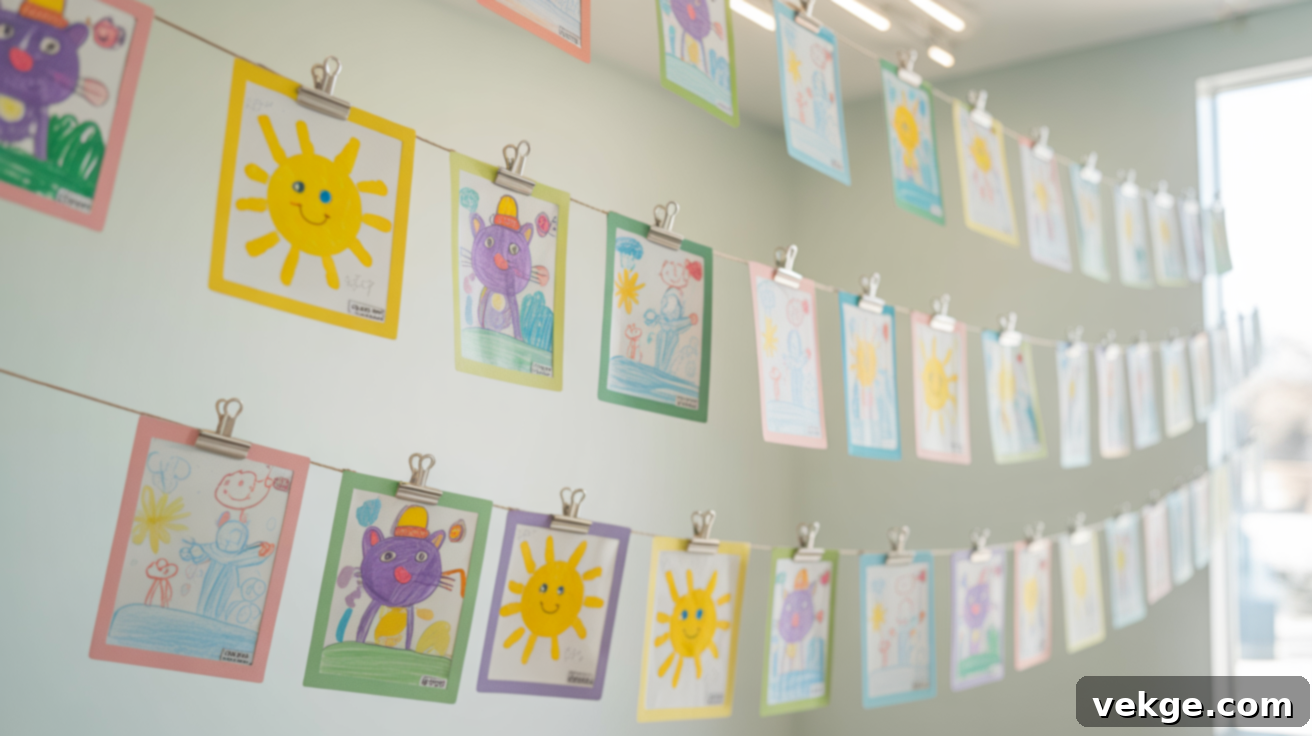
A child’s artwork is a precious treasure, and displaying it proudly can boost their confidence and add unique character to a playroom. In a small space, creative display methods are key to showcasing masterpieces without creating clutter or permanently damaging walls. Consider a rotating gallery system using clipboards, wires with small clips, or even a simple tension rod with curtain rings to hang artwork. This approach celebrates accomplishments while teaching children the concept of curation and rotation.
For prolific young artists, a digital photo frame can display multiple artworks in rotation, reducing the need for physical space. Create seasonal display themes or focus on specific projects to keep the rotation fresh and meaningful. Involve children in selecting which pieces to display, fostering pride in their work and encouraging self-expression. For three-dimensional creations that might be too bulky to display long-term, remember to photograph them before disassembling to preserve memories without sacrificing valuable space.
24. Repurpose or Thrift Furniture for Unique Charm
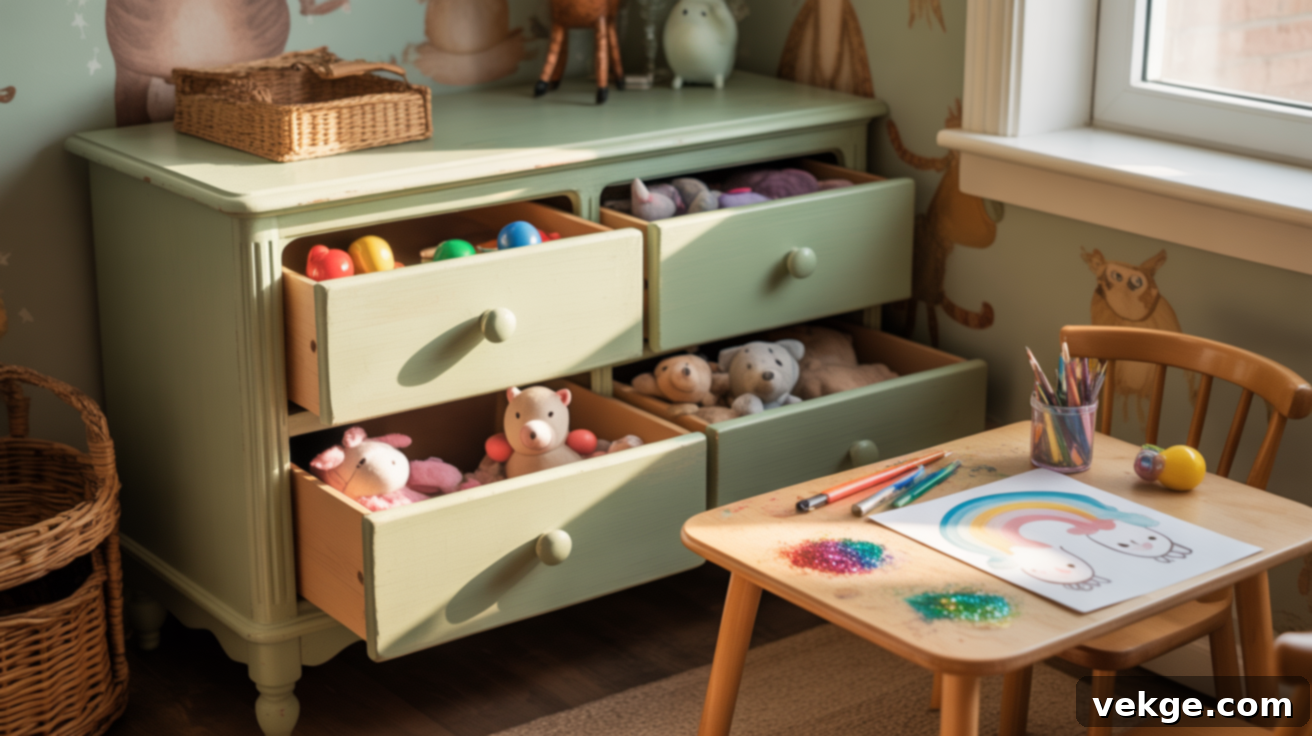
Decorating a small playroom doesn’t have to be expensive. Repurposing or thrifting furniture is not only budget-friendly but also adds unique character and a charming, lived-in feel to the space. Upcycled pieces reduce environmental impact and offer a chance to create something truly custom. For instance, vintage suitcases can become stylish storage for small toys, an old dresser can be transformed into a vibrant art supply station with a fresh coat of non-toxic paint, or an antique trunk can serve as both storage and a coffee table.
Thrift stores, garage sales, and online marketplaces are treasure troves for kid-sized chairs, tables, or small storage units that often cost significantly less than new plastic versions. Look for solid wood pieces that can withstand years of active use and multiple refinishing efforts. Always ensure to sand any rough edges and use non-toxic, child-safe paints and finishes when revamping secondhand items. Involve older children in simple restoration projects to teach them valuable sustainability values and basic DIY skills, making the playroom truly their own.
25. Implement Toy Rotation to Keep Play Fresh
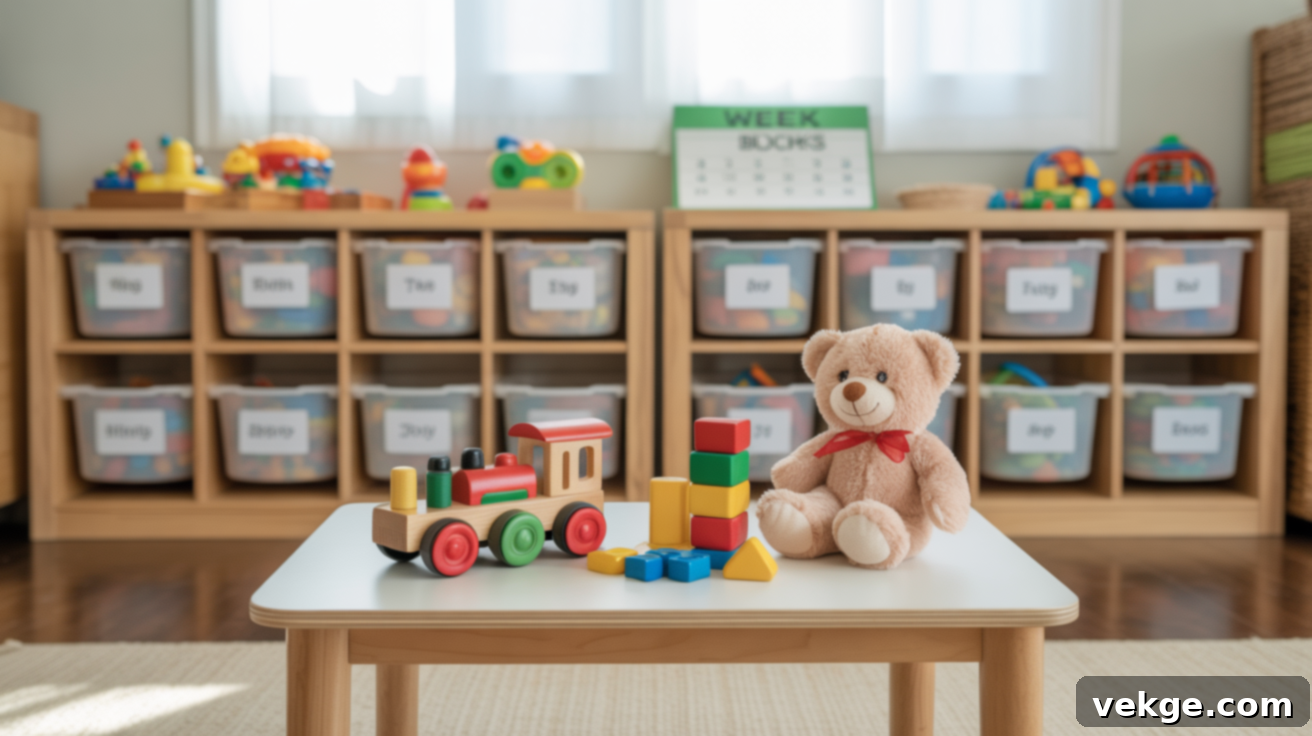
One of the most effective strategies for managing a small playroom and preventing clutter, while keeping children engaged, is implementing a toy rotation system. Instead of having all toys accessible at once, you select a smaller, curated collection to be out. The rest are stored away, only to be “rotated” back into play after a few weeks or months. Children often rediscover items with renewed enthusiasm after they’ve been out of sight for a while, treating them like new toys.
This system significantly reduces visual chaos and teaches the value of quality play experiences over the sheer quantity of possessions. Store excess toys in labeled bins in a closet, under-bed containers, or even a garage, out of sight but easily accessible for rotation. A simple rotation system might involve three bins: current toys, next month’s toys, and seasonal items. The excitement of “new” toys appearing regularly often reduces requests for additional purchases and makes the playroom feel perpetually fresh and stimulating, even with limited space.
26. Choose Montessori-Style Low Shelves
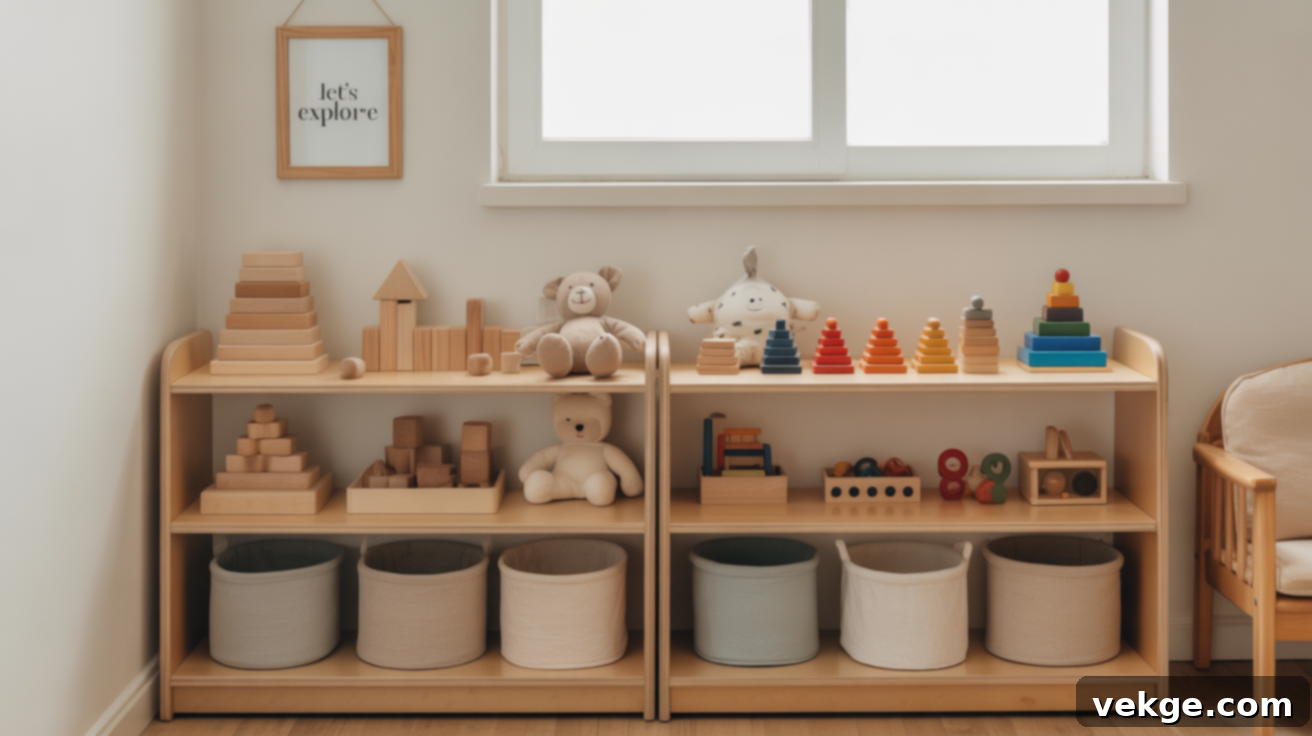
Inspired by the Montessori philosophy, low, open shelving is an excellent choice for a small playroom because it promotes independence and decision-making skills in children. When toys and materials are presented neatly and at child height, children are empowered to select activities themselves and, crucially, to return them when they are finished, all without requiring constant adult assistance. This accessible design fosters a sense of responsibility and order.
Arrange materials neatly on these shelves, grouping similar items together for visual clarity. It’s often recommended to limit the quantities of toys on display at any given time to prevent overwhelming choices, which can lead to scattered play and frustration. Position these low shelves against walls to maximize open floor space for active movement and imaginative play. The simple, uncluttered, and accessible organization inherent in Montessori-style shelving encourages concentration, helps children develop respect for their belongings, and creates a peaceful, engaging learning environment, even in the smallest of rooms.
How to Make Small Playroom Ideas Work for Your Space
Every home has its unique character, and consequently, no two playrooms will ever be exactly alike. The beauty of these small playroom ideas lies in their incredible flexibility and adaptability. You don’t need to overhaul your entire room at once. Instead, approach the transformation thoughtfully, allowing the space to evolve with your family’s needs.
Start by identifying your biggest challenges. Is it an overwhelming amount of toys? A lack of natural light? Or perhaps a tight, awkward layout that feels restrictive? Choose two or three of the ideas presented here that directly address these core issues. For example, if clutter is your nemesis, begin with vertical storage and a toy rotation system. If the room feels dark, focus on light colors and mirrors.
Before committing to major changes, test a few solutions. Try rearranging existing furniture to see if it improves flow, add a single wall-mounted shelf, or define a play corner in a shared living space with a rug. Even subtle updates can make a significant difference in how the room feels and functions. With a bit of trial, observation, and creative thinking, even a hallway nook or a corner of a small bedroom can become a delightful, calm, and easy-to-clean play area. Your space can truly become something both you and your child will love and enjoy.
Common Mistakes to Avoid in Small Playroom Design
While the right color choices and a clever layout can work wonders, some common pitfalls can inadvertently undermine even the best small playroom design plan. Being aware of these mistakes can save you time, money, and frustration, ensuring your efforts lead to a truly functional and inviting space.
- Too much dark color: While a bold accent wall can be impactful, predominantly dark shades on all walls can make a small room feel significantly smaller, cramped, and less inviting. Balance darker tones with plenty of lighter colors on other walls, furniture, or accessories to maintain an open and airy feel.
- Skipping test swatches: It’s tempting to pick a paint color from a chip and go with it, but light changes throughout the day, drastically altering how a color appears. Always paint a small sample swatch on the wall (or a large piece of cardboard) and observe it at different times before committing. This simple step avoids the costly mistake of picking the wrong color that clashes or doesn’t feel right.
- Forgetting the undertone: Every color has an undertone—be it warm (yellow, red) or cool (blue, gray). Ignoring these subtle nuances can lead to a room feeling “off.” Ensure the undertones of your chosen wall colors, furniture, and textiles harmonize with each other. A cool gray wall might clash with warm beige furniture, for example, creating a disjointed look. Understanding undertones helps create a unified and cohesive design.
Helpful Tips for Practical Homes
Designing a functional and beautiful small playroom often comes with practical constraints like tight budgets, rental restrictions, or specific technical limitations. These clever solutions are tailored to address those common challenges, ensuring you can still create a cherished play area that your children adore, without compromising on functionality or aesthetics.
If You’re on a Budget
Creating an inspiring playroom doesn’t have to break the bank. Convert your playroom affordably by making strategic choices. Paint is your most powerful tool; cheerful, vibrant colors can energize the space without straining your wallet. Consider painting just one accent wall for maximum impact, or use stencils for a patterned effect. For storage, repurpose household items: painted cardboard boxes can become colorful toy bins, old crates can be stacked for shelving, and colorful baskets from dollar stores or thrift shops effectively organize toys without expensive systems. Look for affordable fabric bins, DIY pegboards, or simple wall hooks. Get creative with what you already own or can find secondhand.
For Renters
Rental properties often come with restrictions on permanent changes, but that doesn’t mean your playroom can’t be personalized and fun. Temporary peel-and-stick wallpaper in bold patterns can create stunning visual impact without risking your security deposit. Many brands now offer truly removable options designed specifically for renters. Focus on freestanding furniture that you can take with you, rather than permanent installations. Bright rugs, large floor pillows, and colorful curtains add immense personality and comfort while remaining completely portable for your next home. Command hooks are your best friend for hanging art, shelves, or even lightweight organizers without damaging walls. Embrace items that bring joy and functionality without leaving a trace.
When to Call a Pro
While many playroom ideas lend themselves to DIY, some projects are best left to professionals for safety and quality. Consider professional help for any electrical work, such as adding new outlets, installing overhead lighting, or moving light switches. Safety concerns far outweigh any potential DIY savings here, as improperly installed fixtures pose unnecessary and dangerous risks to children. Similarly, safety mounting for items like indoor swings, heavy wall-mounted shelving units, or climbing walls absolutely warrants expert installation. A professional ensures proper weight distribution, secure anchoring into studs, and adherence to safety standards, giving you peace of mind that your active play elements are secure and durable for years of use.
Conclusion
As we’ve explored, the journey to creating a small playroom doesn’t have to feel limiting. In fact, embracing a compact space often sparks incredible creativity, leading to some of the most ingenious and effective design solutions. By making smart layout choices, selecting multi-functional furniture, and implementing clever storage strategies, you can truly open up your space and make it work beautifully for your entire family, fostering an environment of joy, learning, and independent play.
Whether you’re navigating a tight budget, adhering to rental restrictions, or simply working with a tiny room, the 26 ideas shared in this guide are simple to apply and easy to love. Remember, every inch counts, and even small changes can make a monumental difference in how a room feels and functions. You don’t need to tackle everything at once; start with just a few impactful changes, such as implementing a toy rotation system, adding versatile wall storage, or defining a cozy reading nook, and build from there.
Your child’s imagination knows no bounds, and with these practical, playful design ideas, their play space won’t either. Dive in, experiment, and enjoy the process of transforming your small area into a perfectly organized and fun-filled haven. Want more smart home tips and family-friendly design inspiration? Continue exploring our blogs for practical advice that grows with your kids and fits your real-life home.
